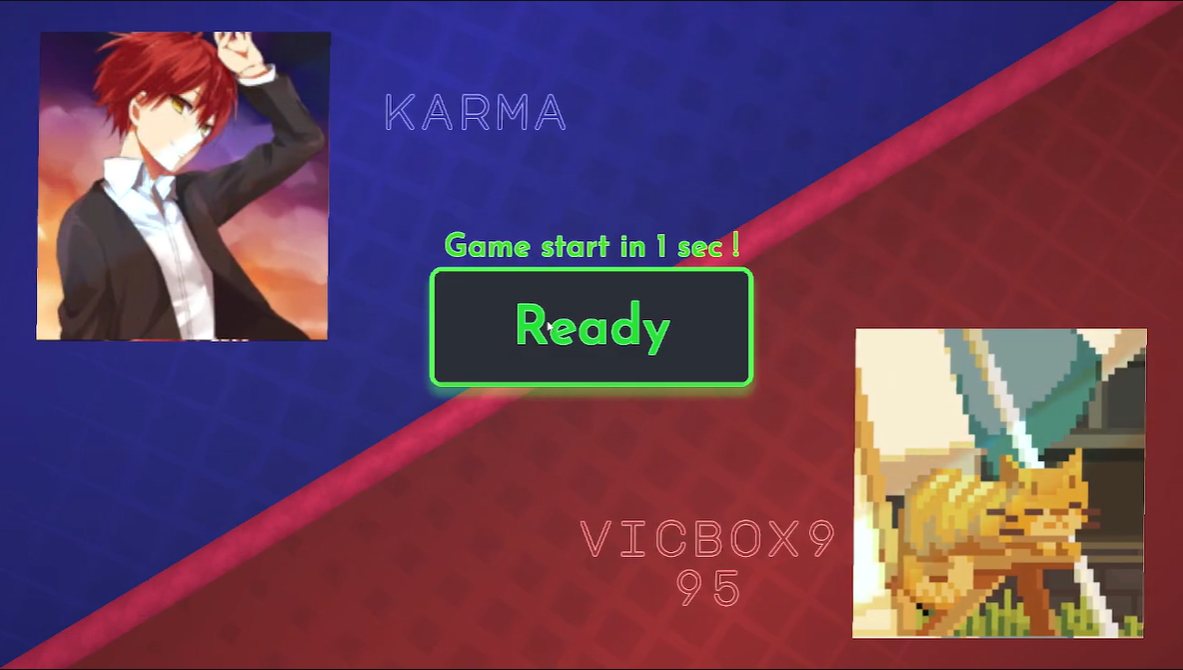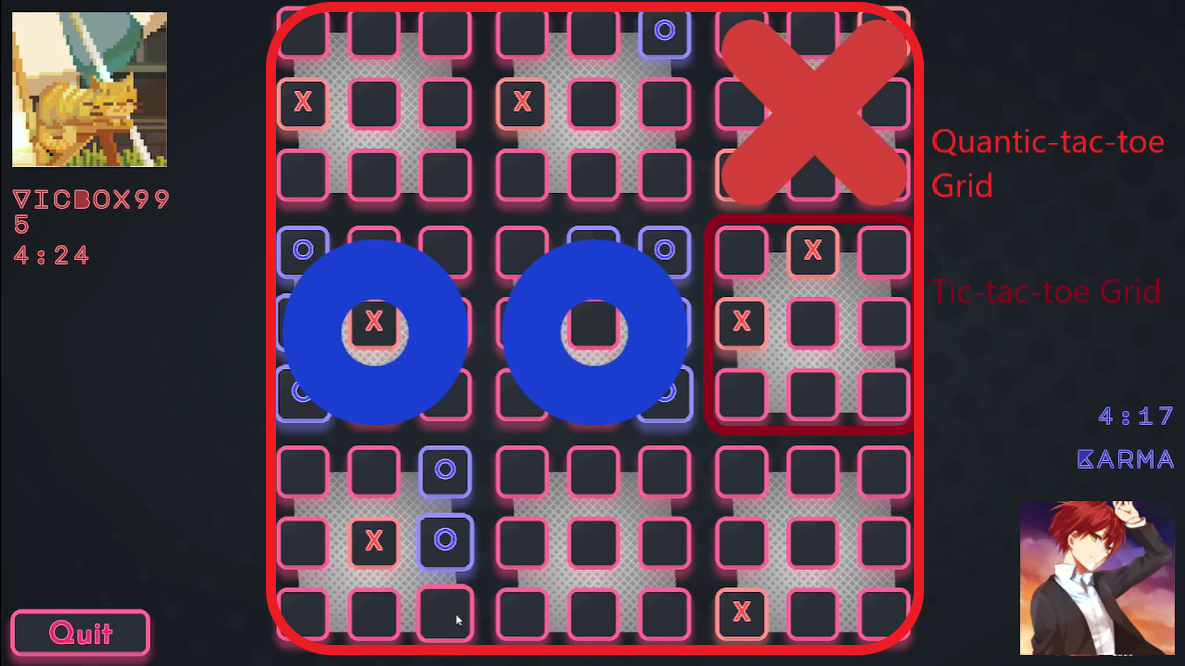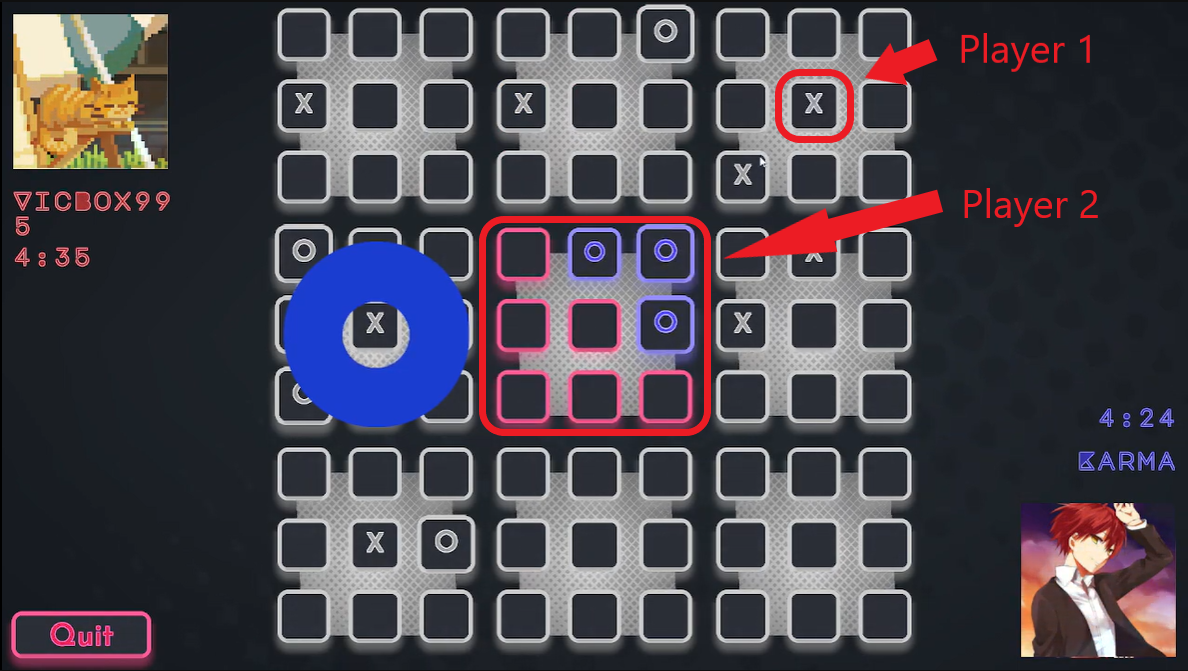💎 Pitch
More challenge, more choices, more strategies.. Would you fight against me ?
🌟 Introduction
Quantictactoe Ultimate tic-tac-toe (also known as Ultimate tic-tac-toe) is a board game composed of nine tic-tac-toe boards arranged in a 3 × 3 grid. Players take turns playing on the smaller tic-tac-toe cases until one of them wins on the larger board. Compared to traditional tic-tac-toe, strategy in this game is different. Players can send their opponent to play in the quantic case they want.
We made this little game at two, trying to find new mechanics to implement into the regular Ultimate Tic-tac-toe
My Objectives were simple, I wanted to find some tweaks to add to the game we all know. Also we wanted to try some things like customization of symbols, special mechanics, maybe quests, etc...

👾 Gameplay
The gameplay is really easy to understand while playing, basicly it's a Tic-tac-toe but times 3 with a little twist.
2 players will play turn by turn and will place a symbol on a little case (that we call the Tic-tac-toe cases).
The little trick is that, in this game there are 9 cases of the regular tic-tac-toe game we know, so when a player plays on the middle left tic-tac-toe case, and put his symbol in the middle, he will "send" the next player in the middle tic-tac-toe case.
Basicly, the micro objective is to complete a line of 3 symbol on a tic-tac-toe case. Once that done, the player getting the symbol obtain his symbol "completing a case" on the Quantic-tac-toe grid.
Twist being that, while you can send the enemy player kinda in the tic-tac-toe grid you want by playing in a strategic case, you have to be careful, because if you send him in a grid that is already completed (Either by you or him), he will be able to play wherever he wants on the Quantic-tac-toe grid.
It's a good balance of strategy and kinda previsualization of what moves the enemy could do, how you can prevent sending him in certain grid that you want to win, or on the opposite sending him on strategic grid that you don't need at all.
Gameplay Video

👨💻 What I've realized on the project

-
The twist
Quantictactoe aka Ultimate Tic-tac-toe being a game that already existed, we firstly wanted to try making a game with the steam API and making a hosting multiplayer game, but we ended wanting to add our little grain of salt in the game.
So we added the Quantic twist, which is as explaned above, sending the enemy player in the Quantic-tac-toe grid you want by playing in a certain tic-tac-toe case.
(Exemple with the image on the left, Player 1 played in the middle case in the top-right tic-tac-toe grid, so Player 2 has to play in the middle Tic-Tac-Toe grid)
-
UI of the lobby
We wanted to have an UI for the main menu that would be juicy and really understandable
For that, we splitted the screen in two, one side for each players, the picture of the player and his name are linked on his steam account so it's automatic.
The button "Ready" being in the middle of the screen to override the splitting line, when Player 1 will click on it, his side will get a nice color and visual effect, same for the Player 2 for his side.
Once both Players are ready, a little timer of 3 seconds start before the game actually lunch, then an animation with a flipcoin giving the first turn to a player randomly will begin.
Players can click again on the ready button even once the timer has started, to cancel it if they're finally not ready.
📌 Lessons Learned
- By asking to some friends multiple times if the game was understandable without real tutorial (Since Tic-Tac-Toe is a known game, we wanted to test the utilisation of our twist mostly). I learnt the importance of feedbacks and iteration loop over some game details to make them more accurate and pleasant.
- During the brainstorming of our twist, we discovered the fact that players could block the game if they choose a case already won by a player, that's why we decided to add the "All cases choice", if a player choose a won case. The lesson here was mostly to think of all the different possibilities, by testing ourselves the game and stress testing the mechanics.
⚡ Quick infos
Project made in 1 Month on Unity
The team :
- Programmers : Victor Lacombe
- Designer : Me (we made the little tweaks and ideas togethers with Victor)
The game is playable by downloading the files, adding it on Steam as a Non-Steam game, and then you can invite your friends through the Steam Contact List


